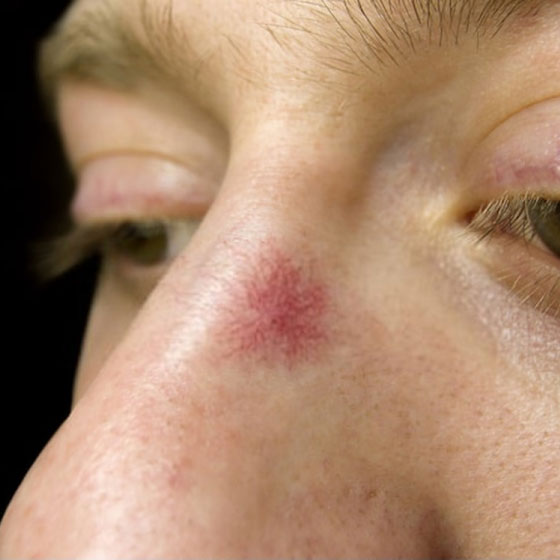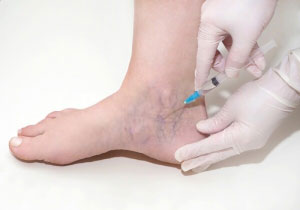If you've noticed small clusters of red, blue or purple thread-like veins on your body, they may be spider veins. These can appear anywhere on the body, but spider veins on the legs are the most common. These branching veins aren't serious but if the appearance of them disturbs you, there are effective treatments to eliminate spider veins.
Spider Vein Appearance
Some people end up with spider veins on the face. They can also show up behind the knee. Up to half of all women get spider veins at some point in their lives, and they get them twice as often as men. Spider veins appear beneath the surface of the skin, sometimes leaving your legs smooth to the touch despite significant veining.
Causes of Spider Veins

Spider veins are minor veins that have twisted, causing blood valves to stop working, trapping blood in short segments.
The veins in the legs are farthest from the heart and have to work against gravity to move blood upward. Because of this, they're the most common parts of the body to get spider veins.
Spider veins that appear on the face are often caused by photoaging or changes in the skin due to sun exposure. They can also appear because of certain skin conditions like rosacea and due to overconsumption of alcohol.
The medical term for the occurrence of spider veins is telangiectasia. It can be caused by several things, including:
- Genetic predisposition
- Exposure to sun and wind
- Taking certain medications
- Standing upright for hours each day
- High alcohol consumption
- Pregnancy
- Obesity
- Acne
 Spider Vein Symptoms
Spider Vein Symptoms
Spider veins on the face, torso, arms and legs are 1-3 millimeters wide. For most people, they cause no discomfort at all. However, some have experienced itching and even pain at the site of spider veins.
It's rare for spider veins in the legs to cause swelling, achiness or tiredness, and it's important to have a complete examination by a physician if you have these symptoms. Rarely, a pattern of spider veins can be a symptom of a more serious condition.
Spider Vein Treatment Options
Once you've noticed spider veins on your body, compression socks and hose can prevent more from appearing. The pressure they exert on the legs can improve the blood flow from the legs to the heart.
Compression stockings can prevent swelling as well, reducing the risk of blood clots in the legs. If you want to eliminate existing spider veins, there are two main ways to treat them.
Sclerotherapy for Spider Veins
This spider vein treatment, also called intravenous hydration therapy, involves injecting a saltwater solution directly into a spider vein. Once a vein has been injected, it collapses in upon itself and is eventually reabsorbed by the body. After a sclerotherapy treatment, you'll wear compression stockings for a couple of weeks and avoid sun exposure at the site of the treatment.
Your doctor will also advise against strenuous physical activity, although walking is advised to prevent blood clots from forming. It may take a few weeks for the small blood vessels to fade, and several treatments may be needed to eliminate them completely.
Click to How Sclerotherapy With Salt Based
Solution Works in Removing Spider Veins
 Laser Treatment for Spider Veins
Laser Treatment for Spider Veins
Laser spider vein removal is the least invasive method of getting rid of the threadlike blood vessels. It's only mildly uncomfortable and recovery time is swift. The laser seals a blood vessel using a focused light beam that causes it to clot and dry up, eventually disappearing. The intense light beam used for spider vein laser therapy doesn't harm the skin at all.
Laser spider vein removal is a simple procedure that's performed in the doctor's office, and most people return to their usual work and activities right away. Just as in sclerotherapy treatment for spider veins, you'll wear compression socks for a couple of weeks and avoid the sun. It can take up to three months for spider veins to disappear completely and more treatments may be needed.
What’s Next
Payment Options
If you have medical coverage, our insurance specialists will help you determine what treatment benefits are covered by your plan. They'll help you figure out the copay and any other out-of-pocket contribution that may be required by your insurer.
If you don't have health insurance, our professionals can help you choose a self-pay option that works for you.
These branching veins aren't the same as varicose veins. The latter involves larger veins that are raised and prominent. Varicose veins can cause intense pain in the legs, and severe cases can even lead to blood clots that increase the risk of deep vein thrombosis (DVT). By comparison, spider veins are more a matter of appearance than a medical issue.
Once the veins are reabsorbed by the body, they're gone forever. However, new spider veins may appear. Here are some tips for maintaining healthy circulation and avoiding more spider veins:
- Wear compression stockings
- Apply sunscreen
- Maintain an optimal weight
- Don't sit or stand for long periods
- Avoid tight clothing
- Drink alcohol only in moderation
- Walk every day
Just click on our invitation for a free vein screening at any of our Florida Vascular Health Centers. Once you've filled out the short registration form, a member of our staff will contact you to set up a free consultation.
You can also call us at (407) 915-9116, and one of our friendly vein care specialists will be glad to answer any questions you may have. Get started and book your appointment today.
Accreditation & Awards, Memberships





 Spider Vein Symptoms
Spider Vein Symptoms Laser Treatment for Spider Veins
Laser Treatment for Spider Veins